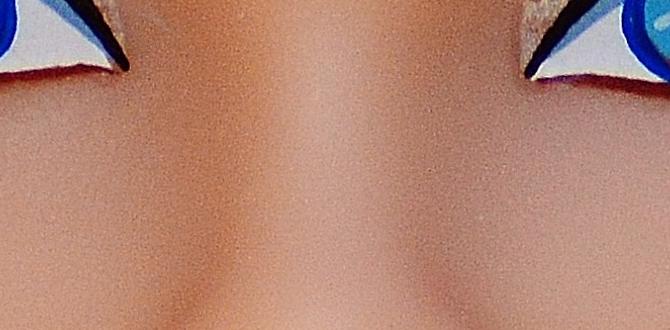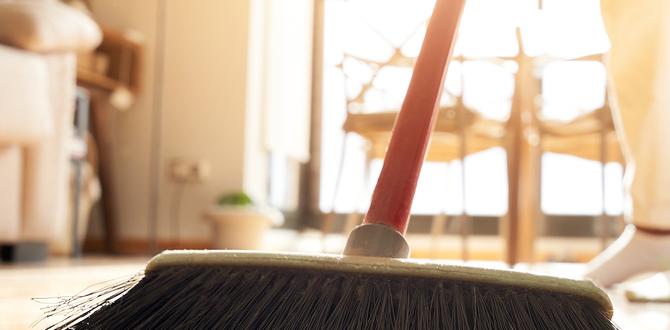Bolded Quick Summary:
To maintain long-lasting nail designs, focus on proper prep, high-quality products, careful application, and diligent aftercare. Protecting your nails from damage and moisture is key to keeping your gorgeous art looking fresh for weeks.
How to Maintain Long-Lasting Nail Design: Proven Tips
Ever spend hours perfecting a stunning nail design, only to watch it start chipping or fading after just a few days? It’s a common frustration, but the good news is that keeping your nail art looking fabulous for longer is totally achievable! With a few smart tricks and a little TLC, you can significantly extend the life of your manicures.
This guide is here to walk you through all the secrets, from the essential prep steps that make a huge difference to the everyday habits that protect your hard work. We’ll cover everything you need to know to keep those beautiful designs looking salon-fresh for as long as possible. Get ready to enjoy your nail art journey even more!
The Foundation: Why Prep is Everything for Longevity
Think of your nail design’s lifespan like building a house – you need a strong, stable foundation. For nail art, this foundation is proper nail preparation. Skipping these steps is like trying to paint a dusty, oily surface; nothing will stick well, and it’ll all fall apart quickly.
Proper prep ensures that your polish and design have the best surface to adhere to, creating a bond that resists lifting and chipping. It’s not just about making it look good for a day; it’s about making it last.
Step 1: Cleanliness is Next to Godliness (for Nails!)
Before any polish or art goes on, your nails must be squeaky clean. This means removing all traces of old polish, oils, lotions, and dust. Any residue can act as a barrier, preventing your new polish from creating a strong bond with the nail plate.
- Remove Old Polish: Use a good quality nail polish remover, ideally one without acetone if your nails tend to be dry. Make sure to get into the edges and under the free edge of your nails.
- Wash Your Hands: Thoroughly wash your hands with mild soap and water. This removes any surface dirt or debris.
- Dry Them Completely: Pat your hands and nails dry with a lint-free towel. Even a little moisture can impact adhesion.
Step 2: Shaping Up for Success
The shape of your nails plays a role in how well polish adheres and how prone they are to breakage. Smooth, evenly shaped nails provide a better canvas and are less likely to catch on things, which can lead to chips.
- File Gently: Use a fine-grit nail file (180 grit or higher is great for natural nails). Always file in one direction to avoid damaging the nail layers, which can lead to splitting. Aim for a smooth edge.
- Choose Your Shape Wisely: While any shape can look beautiful, rounded or squoval shapes are generally less prone to snagging than sharp square or stiletto shapes for everyday wear.
Step 3: Buffing for Better Adhesion
A gentle buff can create a slightly textured surface on your nail plate, giving your base coat something more to grip onto. This is a crucial step for preventing lifting.
- Use a Gentle Buffer: A fine-grit buffer (around 240 grit) is ideal. You don’t need to buff aggressively; just a few light passes across the entire nail surface is enough.
- Avoid Over-Buffing: Buffing too much can thin your nails, making them weaker and more prone to damage.
Step 4: Cuticle Care is Key
Cuticle work is often overlooked, but it’s vital for a clean and long-lasting manicure. Cuticle oil helps keep the skin around your nails healthy, and pushing back cuticles creates a polished look and prevents polish from flooding into the cuticle area, which can cause lifting.
- Apply Cuticle Oil: Massage a small amount of cuticle oil into your cuticles and the surrounding skin. This helps keep them hydrated and healthy.
- Push Back Cuticles: Using a cuticle pusher or an orange wood stick, gently push back your cuticles after applying oil. Never cut your cuticles unless you are a trained professional, as this can lead to infection.
External Link: For more on proper cuticle care and why it’s important for nail health, check out these tips from the American Academy of Dermatology:
https://www.aad.org/public/diseases/cosmetic-treatments/manicures-pedicures
The Application: Quality Products and Techniques Matter
Once your nails are prepped and ready, the application process itself can make or break the longevity of your design. Choosing the right products and using them correctly is essential.
Step 5: The Power of a Good Base Coat
A high-quality base coat is your nail design’s best friend. It acts as a protective layer between your natural nail and the colored polish, preventing staining. More importantly, it provides a sticky surface for your polish to adhere to, significantly reducing the risk of chips and lifting.
- Choose Wisely: Look for base coats that promise good adhesion or are specifically designed for longevity. Gel base coats (if you’re using gel polish) are particularly effective at creating a strong bond.
- Apply a Thin, Even Layer: One thin layer is all you need. Ensure it covers the entire nail plate, including the free edge.
- Cure if Necessary: If you’re using a gel base coat, be sure to cure it under a UV/LED lamp as directed.
Step 6: Color Application – Less is More (Usually!)
When applying your colored polish or nail design elements, thin, even coats are almost always better than thick, gloopy ones. Thick coats take longer to dry, are more prone to smudging, and can chip more easily.
- Thin Coats are Key: Apply two to three thin coats of your colored polish rather than one thick one. Allow each coat to dry (or at least become mostly dry) before applying the next. This ensures thorough curing and a smoother finish.
- Cap the Free Edge: This is a pro tip that makes a huge difference! After applying each layer of polish (base, color, and top coat), gently run the brush horizontally across the tip of your nail. This seals the edge and prevents polish from lifting from the tip, which is a common spot for chips to start.
- For Nail Art: Whether you’re using polish for art, stamping, or stickers, ensure each layer is fully set before moving to the next or applying a top coat.
Step 7: The Unsung Hero – The Top Coat
Your top coat is the protector of your beautiful nail design. It seals everything in, adds shine, and shields your artwork from everyday wear and tear. A good top coat is non-negotiable for long-lasting results.
- Choose a Durable Top Coat: Gel top coats (that need curing) offer incredible durability and shine. For traditional polish, look for quick-dry or long-wear formulas.
- Apply Generously (but evenly): Apply a good layer of top coat, making sure to cap the free edge again. This seals all layers of polish.
- Reapply Top Coat: For traditional polish manicures, consider reapplying a layer of top coat every 2-3 days. This refreshes the shine and adds an extra layer of protection.
Protecting Your Masterpiece: Daily Habits for Longevity
Even with perfect prep and application, your nail design can suffer from daily activities if you’re not careful. Making small adjustments to your routine can protect your art and keep it looking fresh.
Step 8: Be Kind to Your Nails
Your nails are not tools! This is one of the most critical rules for preventing chips and breakage. Using your nails to pry, scrape, or open things is a sure way to damage your manicure.
- Use Tools: Reach for a letter opener, a screwdriver, or even your keys instead of your fingernails.
- Avoid Harsh Chemicals: Exposure to strong cleaning agents or solvents can break down polish and cause it to lift or become dull. Always wear gloves when cleaning or doing tasks that involve chemicals. For more information on chemical safety, consult resources like the Occupational Safety and Health Administration (OSHA).
https://www.osha.gov/chemical-information
Step 9: Moisture Management
Excessive exposure to water can cause your nails to swell and then contract, which weakens the bond between the polish and your nail. This repeated expansion and contraction is a major culprit behind lifting and peeling.
- Wear Gloves: Always wear rubber gloves when washing dishes, doing laundry, cleaning the house, or any activity that involves prolonged water exposure or harsh chemicals.
- Dry Hands Thoroughly: After washing your hands or getting them wet, dry them completely, paying attention to getting water out from under the free edge.
Step 10: Moisturize, Moisturize, Moisturize!
While you want to avoid excessive water, keeping your nails and cuticles hydrated is crucial for overall nail health and flexibility. Healthy nails are less prone to breakage and chipping.
- Cuticle Oil is Your Friend: Apply cuticle oil at least once or twice a day, especially before bed. Massage it in thoroughly. This keeps your cuticles soft and prevents them from drying out and lifting away from the nail plate, which can snag polish.
- Hand Cream: Use a good hand cream regularly, especially after washing your hands. Make sure to rub it into your nails and cuticles.
Step 11: Be Mindful of Impact
Accidental bumps and knocks are inevitable, but being aware of your hands can help you avoid damaging your nail design.
- Awareness of Surroundings: When walking through a crowded space, reaching into a bag, or performing tasks, be mindful of where your hands are.
- Avoid Hard Surfaces: Try not to tap your nails on hard surfaces like desks or countertops, as this can cause chips or cracks.
Special Considerations for Different Nail Designs
Certain types of nail art require slightly different care to ensure they last.
Long-Lasting Gel Manicures
Gel polish is known for its durability, but proper application and removal are key. Ensure you are using a good quality gel base coat, color, and top coat and that you are curing each layer correctly under a UV/LED lamp. Capping the free edge with every layer is paramount. Avoid picking or peeling gel polish, as this can damage your natural nail. Removal should ideally be done by soaking or filing, not forced peeling. For more on gel manicures, check out this FDA consumer update:
https://www.fda.gov/consumers/consumer-updates/uv-lights-and-skin-what-you-need-know
Nail Art with Gems, Glitter, and 3D Elements
These embellishments can add amazing dimension, but they can also be the first to go if not secured properly.
- Strong Adhesive: Use a strong nail glue or top coat (like a builder gel top coat) to adhere gems and larger 3D elements.
- Encapsulate: For a super secure finish, consider encapsulating glitter or small charms within a layer of clear acrylic or builder gel if you have access to these products.
- Careful Top Coating: When applying top coat around gems, avoid flooding them completely unless your top coat is specifically designed for it. This can dull their sparkle. Instead, carefully coat the edges of the gems and the surrounding polish.
Press-On Nails
If you’re using press-on nails, the longevity depends heavily on the adhesive and how well you prep your natural nails beforehand. Clean, oil-free nails and a good nail prep solution will help. For longer wear, consider using nail glue designed for press-ons rather than adhesive tabs. Avoid getting them excessively wet for the first few hours after application.
Troubleshooting Common Longevity Issues
Sometimes, despite your best efforts, you might encounter problems. Here’s how to tackle them:
Issue: Polish is chipping at the tips
Cause: Not capping the free edge properly during application.
Solution: Ensure you cap the free edge with your base coat, color coats, and especially your top coat. If it’s already chipped, you can try filing down the rough edge gently and then reapplying a thin layer of top coat to the tip.
Issue: Polish is lifting at the cuticle or sidewalls
Cause: Oily nail bed, improper prep, or the polish touching the skin/cuticle.
Solution: Thoroughly cleanse and dehydrate your nails before applying your base coat. Ensure your base coat, color, and top coat stay on the nail plate and don’t flood the cuticles. Consistent cuticle oil use can also help keep the cuticle area healthy and prevent lifting.
Issue: Nail art is fading or smudging
Cause: Not fully dry before top coat, or a top coat that reacts with the art.
Solution: Allow each layer of nail art to dry completely before applying a top coat. Some top coats can cause certain pigments (like marker art) to bleed. Test your top coat on a small area first if you’re unsure.
Table: Quick Guide to Longevity Boosters
Here’s a quick reference to the key steps that contribute to a longer-lasting nail design:
| Step | Why It Helps Longevity | Key Action |
|---|---|---|
| Nail Prep | Creates optimal surface for adhesion, removes oils/contaminants. | Clean, buff, dehydrate. |
| Base Coat | Protects nail, provides grip for polish. | Apply thin, even layer, cap edge. |
| Color Coats | Ensures full color coverage and durability. | Apply thin, even coats, cap edge. |
| Top Coat | Seals design, adds shine, protects from wear. | Apply generously, cap edge, reapply as needed. |
| Protective Habits | Prevents physical damage and weakening. | Wear gloves, use tools, moisturize. |
Frequently Asked Questions (FAQ)
Q1: How long should a well-maintained nail design realistically last?
A1: With proper application and diligent care, a traditional polish manicure can last 5-7 days, sometimes a bit longer. Gel manicures, if done correctly, can last 2-3 weeks.
Q2: Is it better to use acetone or non-acetone remover for long-lasting polish?
A2: Non-acetone removers are generally gentler and less drying, which can help keep your nails and the polish more flexible, potentially contributing to longevity. However, for very stubborn polishes, acetone can be more effective. The key is thorough rehydration with cuticle oil and lotion afterward.
Q3: How often should I reapply top coat for traditional polish?
A3: For traditional polish, applying a fresh layer of top coat every 2-3 days can significantly extend the life of your manicure by refreshing the protective seal and shine.
Q4: Can I shower and wash dishes with a fresh manicure?
A4: Yes, but always protect your nails! Wear waterproof gloves for all dishwashing and cleaning tasks. Limit prolonged immersion in hot water, even during showers, if possible.
Q5: My nails break easily. How does this affect my nail design’s lifespan?
A5: Weak, brittle nails are more prone to chipping and breakage, which will naturally shorten the life of any nail design. Focus on improving nail health with regular moisturizing, avoiding harsh chemicals, and ensuring proper nutrition. A good strengthening base coat might also help.
Q6: What’s the best way to keep nail art like intricate details or glitter from falling off?
A6: Ensuring each layer is fully dry or cured before proceeding, using a strong adhesive for embellishments, and applying a durable top coat that seals everything securely are crucial. Capping the free edge also helps prevent those art elements from peeling off with the polish.
Conclusion
Maintaining a long-lasting nail design is all about paying attention




